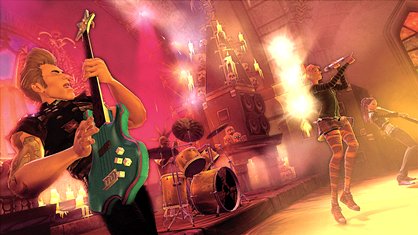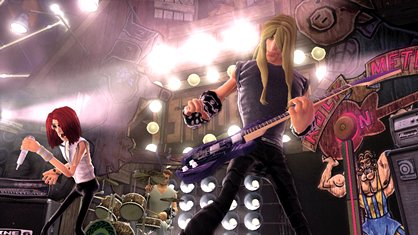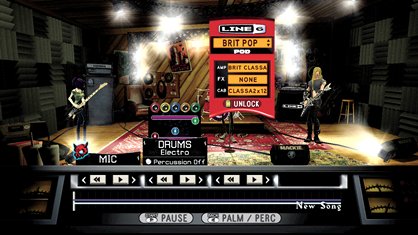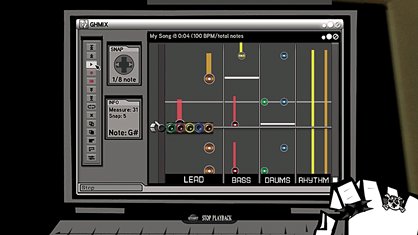Guitar Hero World Tour – hands-on
We’re spilling the beans on the hardest-rocking game on the planet!
Los Angeles may be a town known for the highest excesses of rock n’ roll debauchery (with legendarily wayward rock acts such as Mötley Crüe and Guns N’ Roses synonymous with the city) but Activision’s headquarters – a dull grey box located in sleepy Santa Monica – is hardly the most thrilling place in the world to get our hands on with Guitar Hero World Tour for the first time. But it doesn’t matter, because like Rock Band before it, Guitar Hero World Tour’s full instrument line-up, featuring two guitars, drums and microphone, can give even the dullest corporate meeting room the atmosphere of LA’s famous Troubadour rock venue. Guitar Hero is back – and in the finest tradition of rock flick Spinal Tap, everything in the game has been turned up to eleven.
If there was one thing that made Guitar Hero III a less popular pick than almost anything else over at our house whenever we had people round for some rocking out, it was the utterly diabolical character redesigns. Judy Nails was treated worst, given a makeover that the whore of Babylon would have turned down as “a bit much”, but Neversoft have owned up to their mistake and returned Judy to her alternative rock roots. As Guitar Hero World Tour’s lead designer Alan Flores told us: “We know a lot of fans didn’t like what we did to her. But here at Neversoft we saw it as if Judy made it big and went to LA with Guitar Hero III, falling in with a bad crowd and making a lot of wrong decisions. But she’s left LA and has learned her lesson.” Of course, there’s still the chance that you aren’t going to be satisfied with simply playing as Guitar Hero’s usual characters (though it’s worth noting they’ve brought back our favourite, Eddie Knox) or the still-top-secret list of playable rock stars, and that’s why Neversoft have implemented a full character creator.

Above: All images from the PS3 version
A first for the series – even though Neversoft has been familiar with them since working on the Tony Hawk’s games, you start by picking your gender, your “genre”, and can then modify everything from the distinct positioning and size of facial features to layering unique facepaint and tattoos, or choosing clothes and piercings. The customization doesn’t stop there. Thanks to a zealous lawsuit from Gibson, there are no in-game licensed guitars, and rather than consider it a loss, Neversoft has turned it into something positive with an instrument creator that allows you to create the axe of your dreams. Or drum kit. Or even mic. You can modify your guitar, for example, right down to the shape of the headstock or the colour of the machineheads. It’s up to you.
Custom instruments in game wouldn’t mean anything if the real-world instruments didn’t feel right, and it’s the wireless drums which are the standout. If you’ve ever played a real drum kit, Rock Band’s four-pad drum set will never have satisfied you, as the tight-and-level layout of the pads mean that playing the hi-hat and snare never feels quite natural (especially if you’re used to crossing your arms). Guitar Hero World Tour’s drum kit rewrites the book. The raised cymbals allow you to carry off ultra-realistic (and thrilling!) drum rolls and fills. Perhaps the only place where the drums don’t feel perfect is the foot pedal, which like Rock Band lacks the feedback you’d really get from thumping a bass drum. But for all the extreme metal drummers out there, you’ll be able to add a second pedal for any fast bass drum segments.

The wireless guitar hasn’t been left out of things either, featuring a new Star Power button, and the big addition of a touch slider for slide guitar and two-handed tapping. As a result of these tiny changes, playing guitar and bass at higher levels is a little less ‘pick up and play’ than it has been in the Guitar Hero series before. Bass players now have to deal with “open” notes (played without holding down a fret) as well as the potential to play slap bass, while guitarists now have to be prepared for sections that will be near impossible without using sliding or tapping techniques. We’ve seen some of the patterns for solo sections (for example during Van Halen’s Hot for Teacher) and they areterrifying. As a result of all the new instruments and all the changes, none of the original downloadable content from Guitar Hero III is going to work with Guitar Hero World Tour (Boo!), but the game’s 85+ master recordings softens that blow a bit.
Tracks we managed to get hands-on time with included Interpol’s Obstacle 1 and the Foo Fighter’s Everlong, and whilewe're not able to reveal the full set list, it thankfully includes a decent mix of classic and current tracks that should have a few songs to appeal to everyone, rather than the ‘classic rock’ heavy Guitar Hero III. It’s still very USA-centric, however, but that’s no bad thing. You’ll be playing all of these songs in Guitar Hero World Tour’s five new Career modes, which consist of individual careers for each instrument (including vocals) and an online band career, which allows you to play with a band locally, or if you can’t manage to get three friends together with you, it can be played online with random players or friends. This is especially great as you don’t have to choose one or the other, or even play with the same friends every time.
Sign up to the GamesRadar+ Newsletter
Weekly digests, tales from the communities you love, and more

The Career modes have been improved greatly too. No longer just a linear trip through a selection of pre-booked gigs, it plays far more like a real “world tour” allowing you to choose between gigs in different cities and experience the band lifestyle the way you see fit. If you find, for example, that you’re stuck on a gig at your current difficulty level, you can drop the difficulty level down for that gig and still progress through the game. If you had problems progressing through Guitar Hero III thanks to the absurd difficulty level, Neversoft have promised a smoother ride for everyone this time. There’s less chance of you smashing the guitar into the drumkit in frustration; unless, of course, you’re doing it as part of a Who-style post-gig instrument-demolition ritual.
It would be foolish to claim that Guitar Hero World Tour was anything but a response to Rock Band. What surprisesus, though, is that rather than simply taking heedof Rock Band and copying it, Neversoft has made a concerted effort to improve on every single one of that game’s aspects – from quieter, better laid out andmore responsive drums, to incredibly well-rounded characters and easy instrument customization. We’ve still got some reservations about the game’s complexity (the new custom guitars can be quite bewildering) but this Christmas, it’s likely that Guitar Hero is going to be the king.
A deeper look at the instruments

The Drum Parts
Fancy yourself as Dave Grohl? The drum kit’s pads are incredibly soft (so that there’s no harsh clicking when you thump them) and feel springily responsive. World Tour’s kit features five pads, representing the snare, hi-hat, two tom toms and a crash cymbal. The two cymbals are raised (and individually height-adjustable) so you can set up your kit exactly the way you’d know how to play it for maximum tub-thumping comfort.
Guitar Heroes
Though there’s the new Star Power button, the guitar retains the original accelerometer if you were happier simply jerking your guitar in the air to set off Star Power. A little larger and more “real” feeling than Guitar Hero III’s controller (check out that nice sunburst effect), World Tour’s guitar has that new Star Power button where a real guitar would have its bridge, plus a touch slider placed on the fretboard just south of the traditional row of five buttons for some pedal steel-style sliding.
The Singing Bits
Tapping on the mic will allow you to set off Star Power at any point if you’ve been singing well enough. World Tour’s microphone connects with a wire (after all, who wants to miss out on any Roger Daltry-style microphone swinging?). In-game singing is similar to its peers (SingStar, Rock Band). Stay in tune and in time and you’ll be fine. If you mess up, start again on the next line.
How to record your No.1 hit

1) Using your guitar
Start with the new song wizard to select a tempo and a pre-set bassline. You can select from any tempo and make your own bassline from scratch if you want to.
2) Select a drum loop
You could do this by jamming with a band, but let’s say you’re recording on your own. Starting with drums, select your drum sound (there’s everything from electric kits to rock drums). All done? You can even assign various drum loops to trigger using the fret buttons.
3) Record the rhythm & bass
All the voices use the real code from a Line 6 effects box, so you can be sure your guitars are going to sound realistic. Remember you’ll have to select the note scale that you want the fret buttons to play (you can switch mid-song if you need to).
Sep 2, 2008


